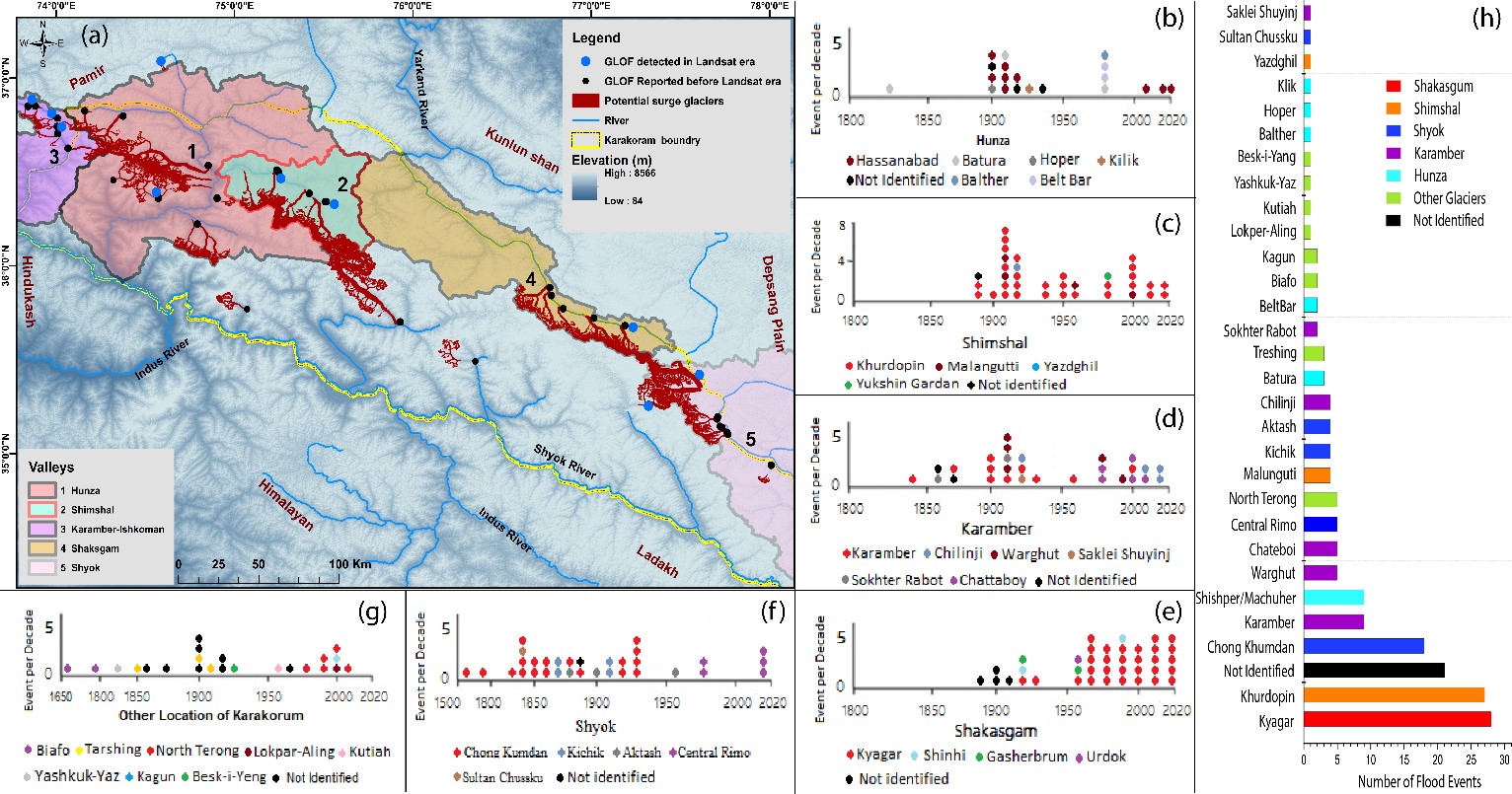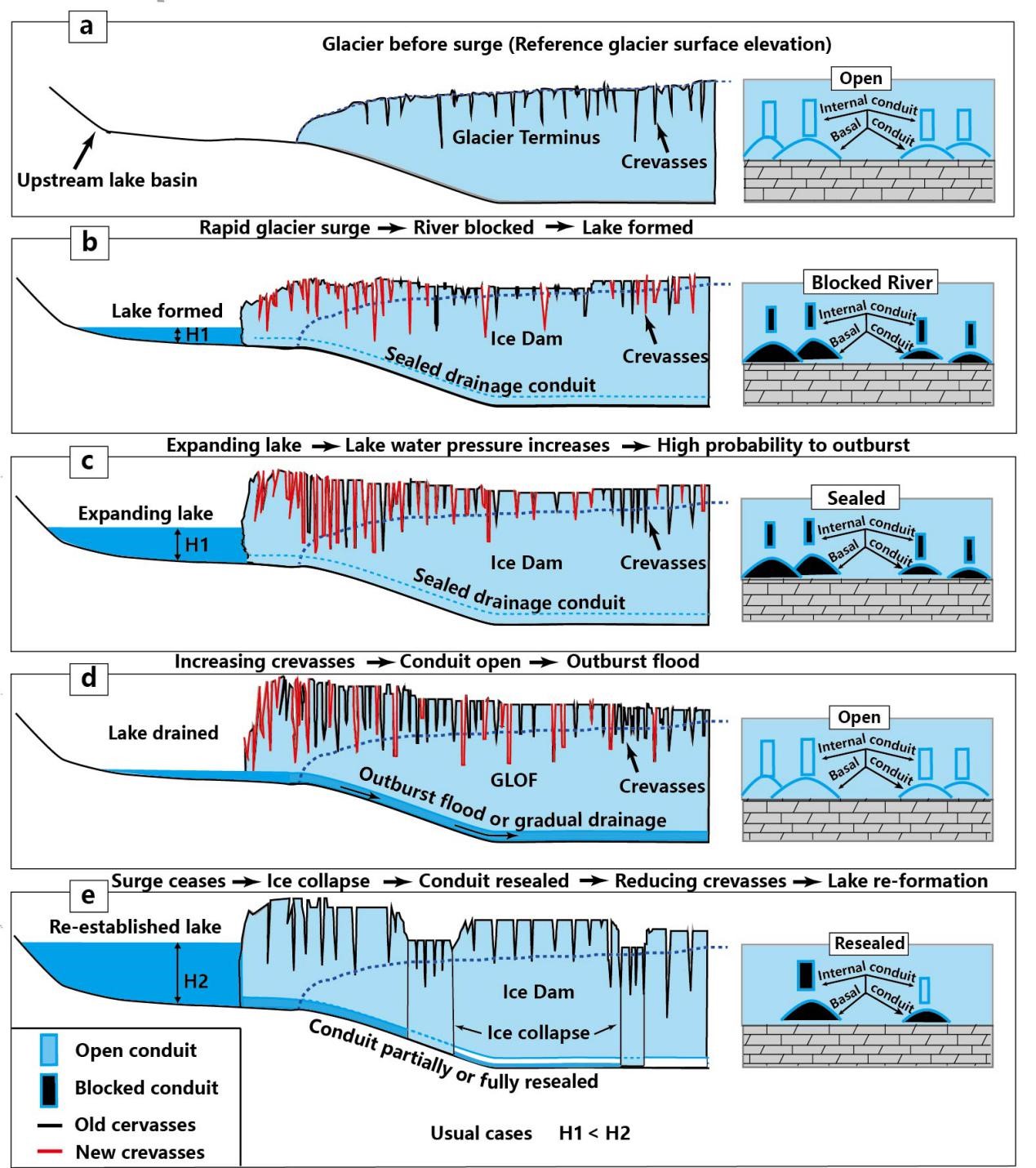In the global context of glacier retreating in response to climate warming, Karakoram glaciers unexpectedly maintain stable or gain in mass which phenomenon is termed as ‘the Karakoram anomaly’. Many of the glaciers in Karakorum region experience irregular, frequent, and sudden advances (surges) that pose an increasing threat of ice dam lake formation and subsequent outburst flooding (GLOFs) throughout the region. However, few researcher have studied the changing trend of GLOFs on decade to century-scale and examined how glacier dynamics impose primary influence on the formation of ice-dam lakes and outburst floods.
A research team of Prof. CUI Peng from Institute of Mountain Hazard and Environment, Chinese Academy of Sciences (IMHE-CAS), conducted a detail field surveys to the responsible glaciers of ice dam lake formation in Central Karakorum, led by Dr. Nazir Ahmed BAZAI and Dr. Hao WANG . This team established a most complete inventory of ice dams and GLOFs since 16st century, as well as temporal and spatial variability of glacier surge in the past 30 years. Furthermore, they proposed a new conceptual model of ice-dammed lake formation and prediction of subsequent GLOFs.
Using historic records, remote sensing data, and field observations, the researchers updated the existing catalogs of glacier surges, ice dam formation, and outburst flooding throughout the Karakoram. The researchers document 179 glacial lake outburst floods (GLOFs) events that occurred from 1533 to 2020 in five major valleys of Karakorum. The result shows two periods of increased ice dam and GLOF generation between 1890-1930 and 1990-2019 (produced 70.7% GLOFs), and a decline between 1940 and 1970.
Abrupt velocity propagate ice volume from the accumulation zone towards glacier terminus, and consequent ice-front advance builds ice barriers in rivers. Due to higher mass transfer to glacier termini the number of resealed lakes recorded higher GLOFs in the inventory.
Identifying the triggering mechanisms of ice-dam failures remains a challenge. However, the findings of the current study enhance the understanding of processes of formation, reformation of lakes and the generation of GLOFs in term of considering: the transfer ice mass elevation towards the termini; fluctuation of velocity during the active and lower surge phase; and variation in crevassing.
Based on 30 years observation, the temporal and spatial variability of glacier surge over Karakorum peaks in early spring and summer months. Analysis of annual velocity estimations for ten glaciers, and six surges cycles of three glaciers, indicates a surge recurrence periods of 15-20 years for Khurdopin, Kyager, Shishper, and Chilinji glaciers; shorter than the likely time-scale of the long-term climatic drivers.
Due to active surge, the high velocity and density of crevasses at terminus result in the initial lake to have a lower volume in contrast to the second or later resealed lakes. Continuous monitoring and predictions of future ice dam formation/GLOF probability is of great importance for safety considerations, water management, as well as formulating and implementing mitigative measures in mountainous regions. The work provides fundamental basis for future studies on prediction of GLOF in response to glacier surge, velocity fluctuation and crevasses development.
This research was supported by the National Natural Science Foundation of China (Grant no. 41941017), Major International (Regional) Joint Research Project and the CAS-TWAS President's Fellowship program. The research titled Increasing glacial lake outburst flood hazard in response to surge glaciers in the Karakoram has been published online in Earth-Science Review.

Figure 1. Glacier lake outburst floods (GLOFs) in the Karakoram five major valleys and total number of GLOFs associated with each Karakoram glacier that has experienced multiple events (Imaged by Nazir Ahmed BAZAI).

Figure 2. Schematic diagram of the process of ice dam formation, lake expansion, and glacier lake outburst flood (GLOF) generation and reestablishment of lake in response to ice volume transference at the terminus. (Imaged by WANG Hao)

Figure 3. The most recent surge cycles of the Khurdopin, Kyager and Shishper glaciers. Images show variations in velocity. The base image in each diagram is from Landsat 8, and yellow circles indicate the locations of dammed lakes (Imaged by Nazir Ahmed BAZAI)
Contact:
Prof. CUI Peng
Institute of Mountain Hazards and Environment, Chinese Academy of Sciences
Chengdu, Sichuan, 610041, China
Tel: 86-28-85214421
E-mail: pengcui@imde.ac.cn
